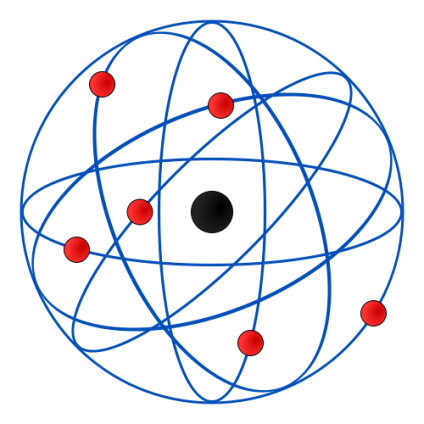
Which of the following is not a postulate given by Rutherford?
A. The positively charged particles are present in the nucleus of atom
B. Size of nucleus is very small as compare to the size of atom
C. The whole mass of the atom is concentrated in the center of atom called nucleus
D. An atom consists of a positively charged sphere, with electrons set within the sphere
Answer
218.1k+ views
Hint: Rutherford conducted an experiment by bombarding a thin sheet of gold with -particles and then studied the trajectory of these particles after their interaction with the gold foil.
Complete step by step answer:
Ernest Rutherford, a British scientist conducted an experiment and based on the observations of this experiment, he proposed the atomic structure of the elements and further gave the Rutherford atomic model. Now, let’s see how Rutherford performed the experiment.
In his experiment, Rutherford directed high energy of $\alpha $ particles from a radioactive source at a thin sheet of gold. In order to study the deflection caused by the alpha particles, he placed a fluorescent zinc sulphate screen around the thin gold foil.

Now, after performing the experiment, he concluded that:
The nucleus is at the center and is positively charged and nearly all the mass of the nucleus resides in the nucleus. He also said that electrons revolve around the nucleus in a circular path. Also, the size of the nucleus is very less as compared to the size of the atom.
Therefore, he never concluded that the atom consists of a positively charged sphere, with electrons set within the sphere.
Hence, option D is correct.
Note: Although the model was based on the experimental observations, it further failed to explain certain things such as he did not say anything about the arrangement of electrons in an atom which made his theory incomplete. Moreover, the model could not explain the stability of an atom as well.
Complete step by step answer:
Ernest Rutherford, a British scientist conducted an experiment and based on the observations of this experiment, he proposed the atomic structure of the elements and further gave the Rutherford atomic model. Now, let’s see how Rutherford performed the experiment.
In his experiment, Rutherford directed high energy of $\alpha $ particles from a radioactive source at a thin sheet of gold. In order to study the deflection caused by the alpha particles, he placed a fluorescent zinc sulphate screen around the thin gold foil.

Now, after performing the experiment, he concluded that:
The nucleus is at the center and is positively charged and nearly all the mass of the nucleus resides in the nucleus. He also said that electrons revolve around the nucleus in a circular path. Also, the size of the nucleus is very less as compared to the size of the atom.
Therefore, he never concluded that the atom consists of a positively charged sphere, with electrons set within the sphere.
Hence, option D is correct.
Note: Although the model was based on the experimental observations, it further failed to explain certain things such as he did not say anything about the arrangement of electrons in an atom which made his theory incomplete. Moreover, the model could not explain the stability of an atom as well.
Recently Updated Pages
Apparent Frequency Explained: Formula, Uses & Examples

Calorimetry: Definition, Principles & Calculations

Centrifugal Force Explained: Definition, Formula & Examples

Charge in a Magnetic Field: Definition, Formula & Examples

Combination of Capacitors: Series and Parallel Explained

Compressibility Factor Explained: Definition, Formula & Uses

Trending doubts
JEE Main 2026: Application Form Open, Exam Dates, Syllabus, Eligibility & Question Papers

Derivation of Equation of Trajectory Explained for Students

Hybridisation in Chemistry – Concept, Types & Applications

Understanding the Angle of Deviation in a Prism

Understanding Collisions: Types and Examples for Students

How to Convert a Galvanometer into an Ammeter or Voltmeter

Other Pages
NCERT Solutions For Class 11 Chemistry Chapter 7 Redox Reaction

JEE Advanced Marks vs Ranks 2025: Understanding Category-wise Qualifying Marks and Previous Year Cut-offs

NCERT Solutions ForClass 11 Chemistry Chapter Chapter 5 Thermodynamics

Thermodynamics Class 11 Chemistry Chapter 5 CBSE Notes - 2025-26

Equilibrium Class 11 Chemistry Chapter 6 CBSE Notes - 2025-26

Understanding Atomic Structure for Beginners




